For best exprience view on a desktop computer using full screen.
0%
For best exprience view on a desktop computer using full screen.

Chapter Three
Scroll Down
“With a good burgundy to brace the rather muddy tone of the main dish, we toasted the past and present in the long evening twilight — a taste of the Pleistocene ..."
“We find that on different continents the climate changes happened at different times, but they all showed a similar kind of feature, that moisture levels changed just prior to extinction,”
Walter Roman had found many ancient bones as he washed muck from atop gold-bearing gravels at his mine. In midsummer 1979, he uncovered something new: hooves and legs with flesh and skin still attached.
Professor Dale Guthrie, a UAF paleontologist, got the call to come take a look. Guthrie saw the appendages of a long-frozen ancient bison sticking from the mud bank next to Pearl Creek.
Roman moved his washing operation to let the carcass thaw gently. Guthrie and his wife, Mary Lee, spent about two weeks gradually excavating it. The skin was covered in vivianite, an iron phosphate that turns blue when exposed to oxygen, so they dubbed the bison “Blue Babe,” recalling Paul Bunyan’s mythical ox.
After hauling the carcass to the university and refreezing it, Guthrie began analyzing Blue Babe’s details. He determined the bison lived about 35,000 years ago, but how did he die? Why he was so well preserved? What was the environment like then?
Guthrie matched puncture wounds in the hide with teeth from a Pleistocene lion skull in the museum. A fragment of lion’s tooth was later found in the skin. The fragment — no doubt broken when the lion tried to take a bite of frozen bison — the lack of decomposition and maggots, and ample body fat indicate Blue Babe was a healthy animal killed in the winter. The next spring, silt carried by snowmelt or rainwater buried the carcass.
The Guthries and others even cooked a bit of the 35,000-year-old meat in a stew.
Most of Blue Babe's skin was preserved and is now publicly displayed on a model at the museum.
The head and horns were kept frozen, and they continue to reveal not only Blue Babe’s story but also the Earth’s. UAF Professor Matthew Wooller and others analyzed nitrogen isotopes, which reflect an animal’s diet, in collagen extracted from the bones. That analysis helped Wooller and other scientists confirm in a 2017 report that moisture spiked just prior to extinctions of many of the large species that populated the dry ice age steppe.
Read an article written by Lauren Frisch, "Moisture played a role in megafaunal extinctions."
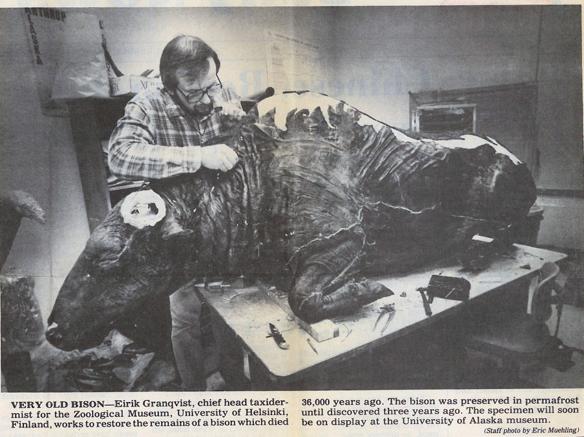
VERY OLD BISON - Eirik Granqvist, chief head taxidermist for the Zoological Museum, University of Helsinski, Finland, works to restore the remains of a bison which died 36,000 years ago. The bison was preserved in permafrost until discovered three years ago. The specimen will soon be on display at the University of Alaska’s museum.
File: Photo from the University of Alaska Museum of the North's spotlit article, "BON ANNIVERSAIRE, BLUE BABE."

Professor Dale Guthrie conducts necropsy work on Blue Babe's head, which was refrozen to preserve it. UAF researchers today are conducting sophisticated chemical analysis on collagen tissue from the head to reveal the bison's diet.
Photo by UAF Institute of Arctic Biology, reprinted from "Blue Babe: The Story of a Steppe Bison Mummy from Ice Age Alaska," by Mary Lee Guthrie.

Blue Babe's head lies in the mud shortly after having been discovered by gold miner Walter Roman north of Fairbanks.
Photo reprinted from "Blue Babe: The Story of a Steppe Bison Mummy from Ice Age Alaska," by Mary Lee Guthrie.
Several Alaska Native students who attended the university’s during its first decades successfully graduated and put their college educations to work in various ways. Examples included Flora Jane Harper, Tim Twitchell and Arthur Nagozruk Jr. — who were respective Athabascan, Yup’ik and Inupiaq graduates from the university’s first three decades.
However, by the 1970s it was clear that too few Alaska Native students enrolled, and, of those who did, too few finished. In 1982, leaders of the Alaska Federation of Natives, meeting at the Fairbanks campus, asked the university to help better prepare college-bound Native students. UAF created the Rural Alaska Honors Institute to answer that call; the academy’s first summer was 1983.
The program has adapted over the years, but the basic approach remains the same: Students from rural Alaska live on the Fairbanks campus for several weeks while taking college courses and participating in recreational and cultural activities.
Teachers include not only UAF faculty but also others from around Alaska and even the Lower 48.
During the first decade, students were graded on effort and achievement. In 1994, students began receiving standard, graded university credits in the core classes. Jim Kowalsky, who became RAHI director in 1986 and would lead it for the next 18 years, described the change as “a large leap.”
Students might not be as willing to take tough classes, he noted in the 1994 yearbook, and there were questions about fairness when some students had lighter loads than others. On the positive side, “the RAHI credit track allows students to enter college as full-time freshmen with anywhere from eight to 16 or more college credits already earned — the equivalent of more than one semester,” he wrote.
In 2006, the American Institutes for Research found that rural Alaska Native students were twice as likely to earn a bachelor’s degree if they had attended RAHI.
Enrollment has risen and fallen with budgets. In 1993, following state cuts, only 27 students could be enrolled. In 2016, the 68 students comprised the largest graduating class. Kowalsky was that year’s keynote graduation speaker.
"RAHI is one of the few programs that successfully combines formal and social educations. Not only do you polish writing and other technical skills, but you have the opportunity to learn how to interact with professors and live in a group setting.”

RAHI student Jennifer Ruiz, 17, of Togiak, dances a tradtional Alaska Native Dance with the young women during dance class.
UAF photo by JR Ancheta.

Sporting the traditional-white gi, students of the Rural Alaska Honors Institute learn basic karate skills during their physical education class.
UAF photo by JR Ancheta.

RAHI student Aaron Ulroan of Chevak learns traditional Alaska Native Dance at the at the Salisbury Theater.
UAF photo by JR Ancheta.
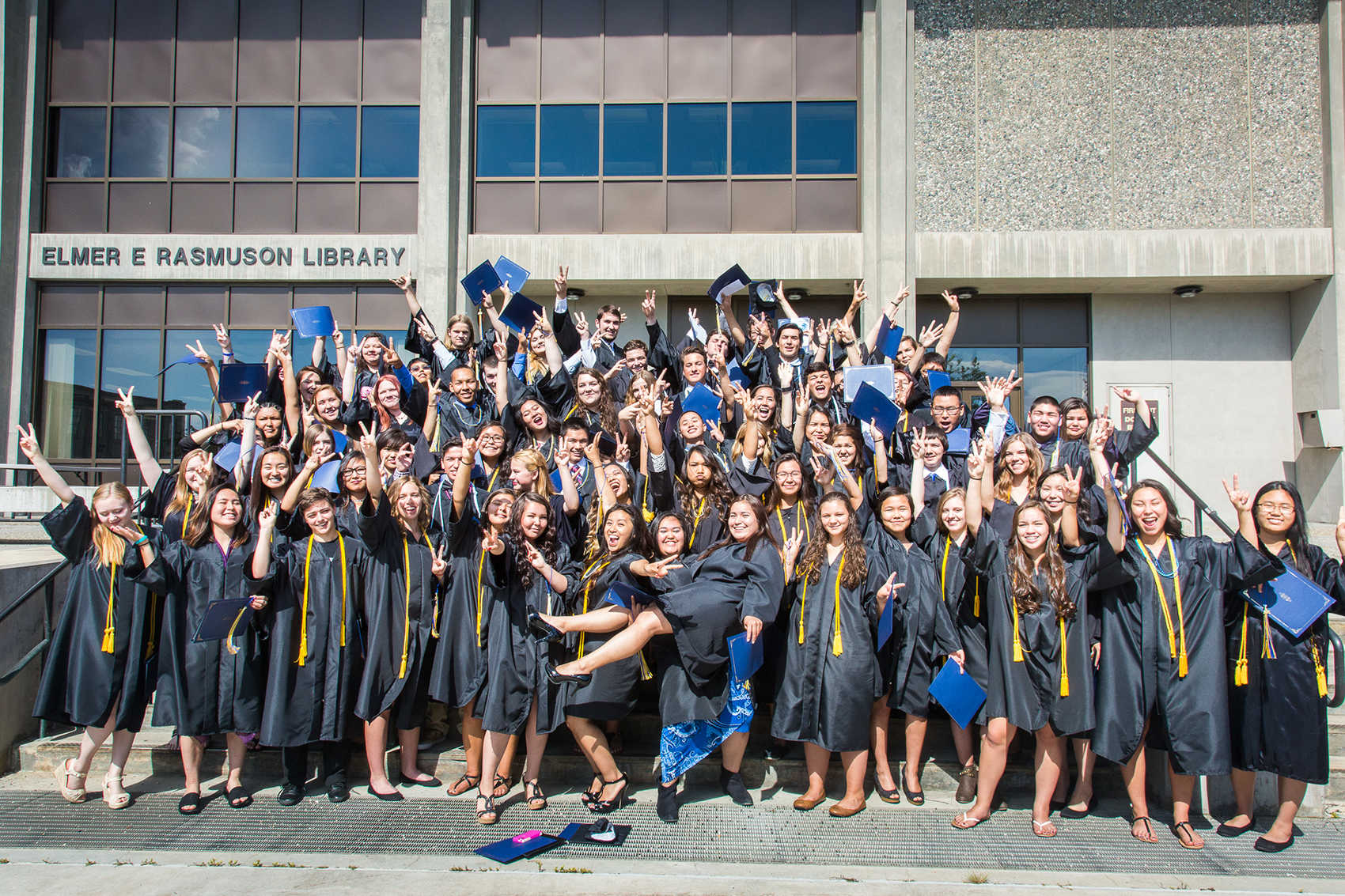
Graduates of the 2016 Rural Alaska Honors Institute gather for a portrait outside the Rasmuson Library
UAF photo by JR Ancheta.
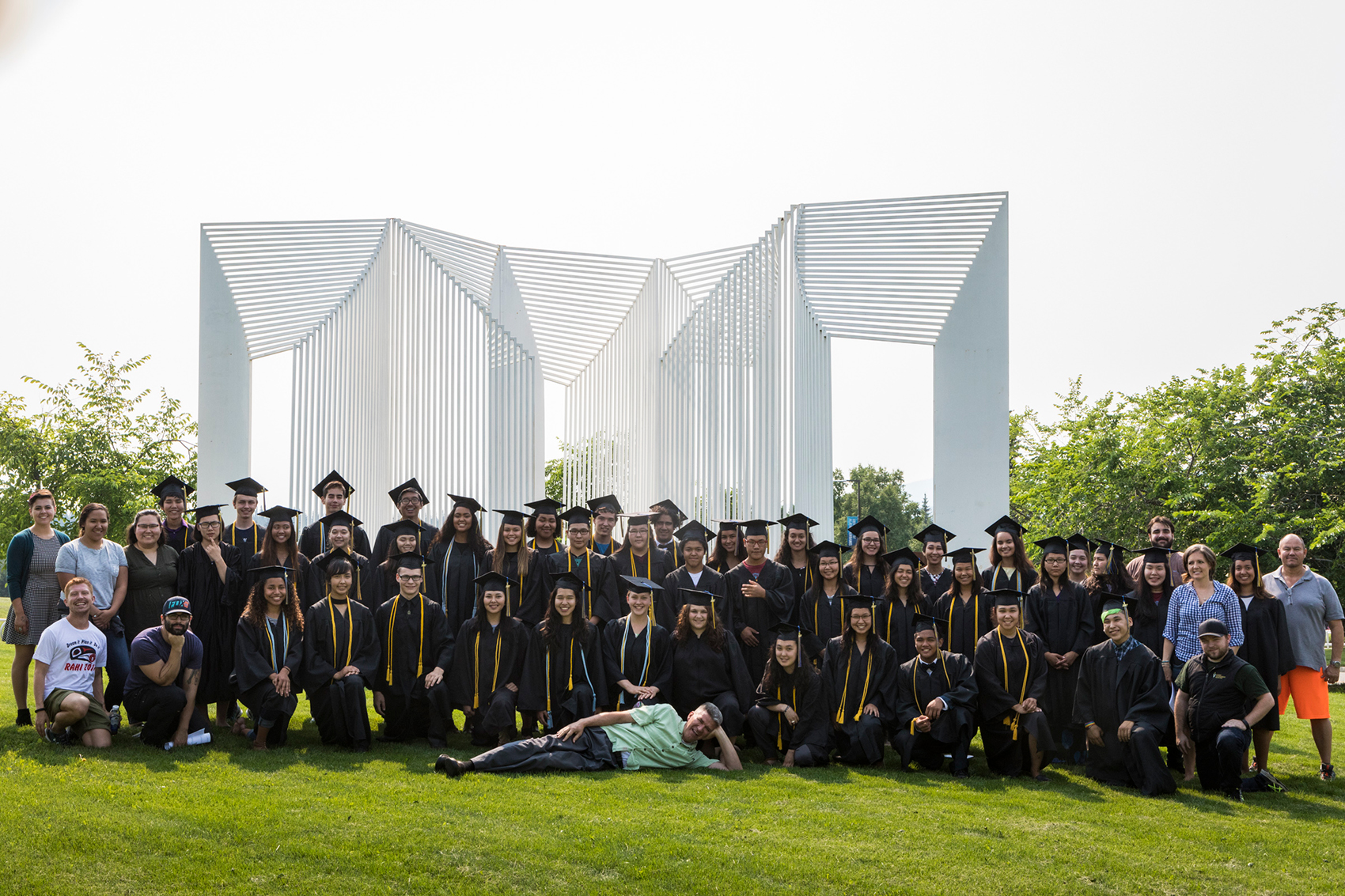
The 2017 Rural Alaska Honors Insitute participants gather in front of the Elysian sculpture at the Fairbanks campus.
UAF photo by JR Ancheta.
KSUA, broadcasting from the Fairbanks campus at 91.5 FM, continues a tradition of student-led radio that spans more than half of the university’s 100 years. KSUA FM began public broadcasts as an independent, student-owned commercial station in 1984. It shut down briefly after financial problems in 1993 and returned later that year as a university-owned, student-operated station, which it remains. In 2013, KSUA won the Woodie Award presented by MTV to the nation’s best college radio station.
KSUA FM opened its first broadcast on Sept. 6, 1984, with the Steely Dan hit “FM (No Static at All),” according to Jerry Evans, a Fairbanks radio veteran who helped launch the student station.
Evans and his buddy, Glen “Glenner” Anderson, had started their popular banter on KMPS, the low-power student station that transmitted across campus over electrical wires for much of the 1970s.
KMPS wasn’t the first student station of that sort. The first, KUOA, powered up in 1955 in Room 115 of the Eielson Building. Its carrier current system performed poorly. So students sold the KUOA license to what became KUAC, the university’s public radio station, in 1962. A decade later, student government started KMPS, which was then phased out as the nonprofit Student Media Inc. launched KSUA.
In 1984, with KSUA’s public signal at 103.9 FM, the student station gathered a much wider audience. Its mix of singles and album-oriented rock in a wide variety of genres drew listeners not only on campus but also in the greater Fairbanks area. However, an economic downturn caused by low oil prices hit the state in the late 1980s, and then multiple competing stations opened in Fairbanks in the early 1990s. KSUA couldn’t overcome its financial problems and closed on March 8, 1993, playing Pearl Jam’s “Alive.”
In the following months, Student Media Inc. was dissolved and the university acquired the license. On Dec. 2, 1993, the station began broadcasting again, opening with “Alive.”
Today, the university continues to hold the license in trust for students. The station is managed by the Associated Students of UAF via the KSUA Media Board. In addition to student employees, dozens of volunteers help keep the station running from its studio in Constitution Hall. KSUA now broadcasts on 91.5 FM after trading its 103.9 position to a Fairbanks commercial station.
In the Fairbanks Daily News-Miner: KSUA student-run radio station at UAF voted country's best
In The Sun Star: KSUA dominates student division of AK Broadcasters Association awards
“It’s one thing to hear your college radio station is cool. It’s another thing to hear it from MTV.”
“No one listens to our station. No one could listen if he wanted to.”

Using a sweet set up to record the newest Take-Out Session with The Dilemma this afternoon.
Photo from KSUA's Facebook page.

KSUA broadcasts during the Goldpanners Midnight Sun game at Growden Memorial Park.
Photo from KSUA's Facebook page.

Our DJs are the classiest of multi-taskers. DJ Tupacrates of the SOAP radio hour with Kareem Abdul Jafar.
Photo from KSUA's Facebook page.
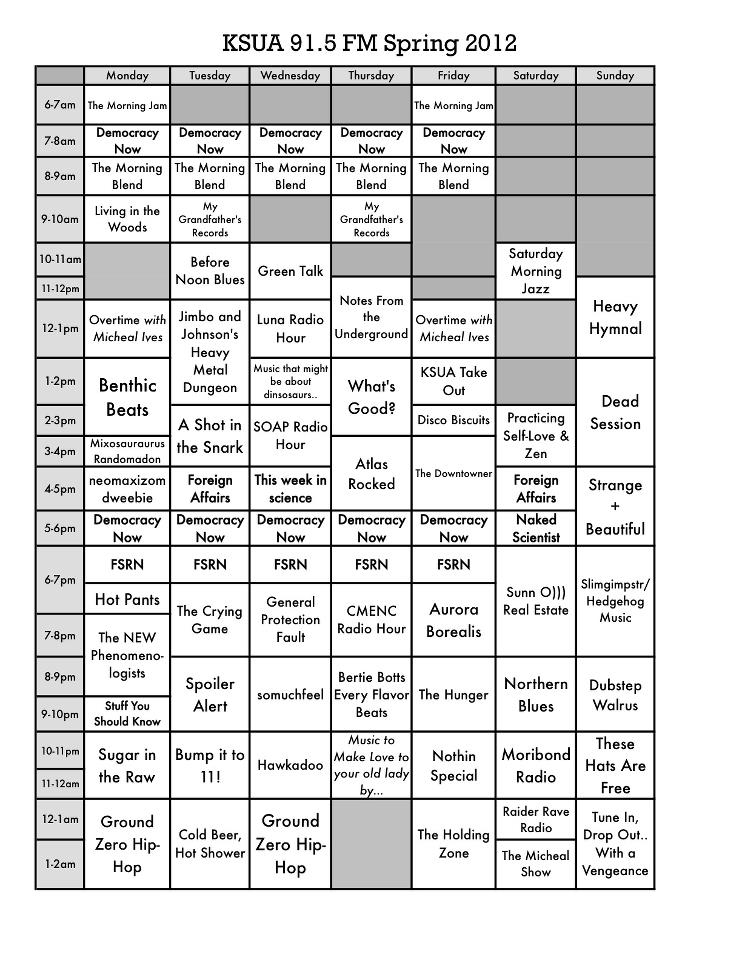
Great programming lined up for spring semester 2012
Photo from KSUA's Facebook page.

KSUA DJ meetings At UAF Constitution Hall.
Photo from KSUA's Facebook page.

KSUA pub party With Travis Burrows and Danny Opgenorth.
Photo from KSUA's Facebook page.

The KSUA booze cruise bus would load up a bunch of students and bring them to Chena Lakes to PARTY!
Photo from KSUA's Facebook page.
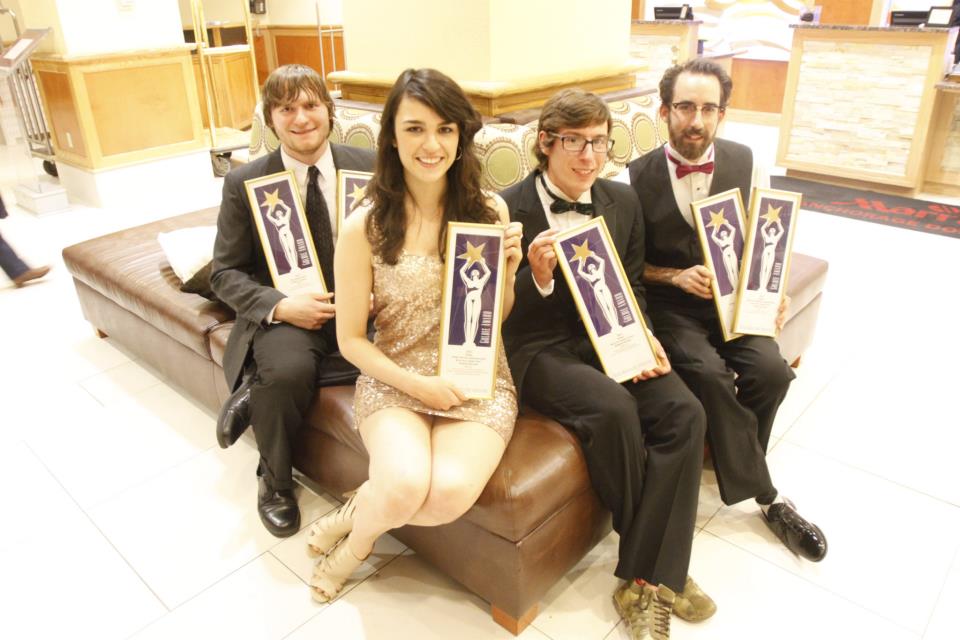
Eli Barry-Garland, Annie Bartholomew, Mickey Zakurdaew and Brady Gross in Anchorage, Alaska accepting KSUA's 2012 Goldie Awards.
Photo from KSUA's Facebook page.
KSUA FM opened its first broadcast on Sept. 6, 1984, with the Steely Dan hit “FM (No Static at All),” according to Jerry Evans, a Fairbanks radio veteran who helped launch the student station.
Published on Dec. 29, 2010 on YouTube by rt24681012
Published on April 27, 2017 on YouTube by University of Alaska Fairbanks
KSUA 91.5 Harlem Shake, published on Feb. 16, 2013 on YouTube by KSUA Multimedia
State general fund revenue, which topped $4 billion in fiscal year 1982, had dropped to just over $1.5 billion by fiscal year 1987. Much of the drop came in the first eight months of 1986, when oil prices crashed from $28 per barrel down to $10.
In mid-1986, Gov. Bill Sheffield rescinded 15 percent of the university’s fiscal year 1987 funds. UA President Donald O’Dowd established a restructuring team that traveled to campuses. In October, after Sheffield demanded another 15 percent cut in the coming fiscal year, O’Dowd presented his plan to the regents.
O’Dowd proposed to merge the community colleges with the three main universities in Fairbanks, Anchorage and Juneau. The Cooperative Extension Service, which since the mid-1970s had been housed with community colleges in an Anchorage-based statewide administrative unit, would return to Fairbanks. A statewide fisheries school, based in Fairbanks, would be formed by merging programs around the state. Regents adopted O’Dowd’s plan, with a few modifications, at their December meeting.

Need caption
Newspaper article from the Fairbanks Daily News-Miner during 1987
Download PDF of article
Within the next few months, legislators filed bills and activists started an initiative drive to break the community colleges out of the UA system. School districts and community college supporters filed lawsuits to stop the regents’ plan. The community college faculty union filed an unfair labor practice complaint against the university. Individuals filed more lawsuits.
The regents didn’t back down, and the restructuring went into effect on July 1, 1987. More than 100 positions were eliminated, including two chancellors, five vice chancellors, eight deans, and 19 directors and campus presidents. Community college faculty were offered contracts ranging from full tenure to one-year contracts, depending on their past service length.
The restructuring subsequently survived most of the challenges, and today’s university largely reflects the decisions made by regents in December 1987. The Cooperative Extension Service is now part of the UAF School of Natural Resources and Extension.
The community college in Fairbanks had a few names but in 2010 became the Community and Technical College. In 2002, the state of Alaska gave its former courthouse and agency building in downtown Fairbanks to UAF to house the college. It was extensively renovated between 2008 and 2012.
The structure of UAF continues to change, though, especially with the advent of online courses made possible by high-speed internet connections. Three percent of classes were offered online in 2001; 18 percent were in 2010. In 2011, more than half of UAF students took at least one online course for the first time in the fall semester.
“Despite the most dramatic general funding reduction to an entire state public higher education system since World War II, the actions taken avoided closing entire institutions, maintained course and program offerings, and allowed the University of Alaska system to avoid the long-term negative effects of exigency or significant academic program elimination.”
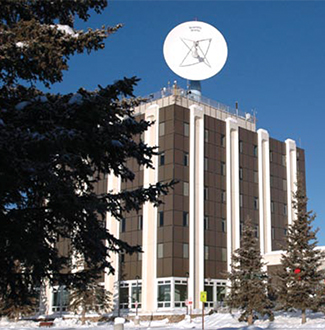
After installation of AS2 was completed in 1991.
Photo © Lester Lefkowitz
The Alaska Satellite Facility began in 1991 as the Alaska Synthetic Aperture Radar Facility, a name that reflected the type of data it received from the ERS-1 satellite launched by the European Space Agency.
Synthetic aperture radar bounces a signal off the surface of Earth to detect physical properties. Those include shape, roughness and vegetation cover. Unlike optical sensors, such as those on Landsat satellites, SAR can see through darkness, clouds and rain. This makes it ideal for watching everything from erupting volcanoes to sea ice. It can even help analyze earthquake damage and oil spills.
Fairbanks is an ideal location to collect SAR data from polar-orbiting satellites. Such satellites orbit about 400 miles above the Earth in roughly north-south tracks. The Earth rotates beneath them. So a ground station close to a pole has direct, line-of-sight contact with the satellite for far more time each day than a ground station located closer to the equator would. That contact is necessary to establish a radio connection adequate to download the SAR data.
Polar-orbiting satellites travel fast. They’re only in view of the antennas on UAF’s West Ridge for about 15 minutes on each pass around the Earth.
The big blue antenna atop the Elvey Building on West Ridge was installed in 1989.
NASA contracted with the Alaska SAR Facility to download the data. Gunter Weller, now a UAF professor emeritus, oversaw the facility’s creation. From the start, the facility, part of the UAF Geophysical Institute, has been funded by contracts and grants.
The Alaska Satellite Facility celebrated its 25th anniversary in 2016. Today, the ASF has three arms. One archives more than 2.5 petabytes of synthetic aperture radar data and imagery for distribution to scientific users around the world. The second operates the ground station, with three NASA antennas — the one of the Elvey Building plus two more 11-meter dishes in the woods just to the west. The third arm operates a separate, off-campus, full-service ground station, using university-owned antenna systems to support space agencies, small-satellite operators and data providers.
The original big blue antenna was replaced in summer 2017 with a new, slightly smaller antenna that not only receives data but also transmits commands to satellites.
““Every year, ASF leaders get together to discuss long-term planning. … We develop a big, hairy, audacious goal, or BHAG, to inspire us to reach further. Our adopted BHAG, particularly suitable in this year of our 25th anniversary, is: ASF will lead the revolution in the way the world uses remote-sensing information.”
Protest photo by Genezaret Barron scanned from Terrence’s book, The Cornerstone on College Hill.
Facing budget limitations in the early 1990s, UAF leaders were looking for ways to raise money. At the same time, major retail firms were looking for Fairbanks sites to develop into malls like those that dominated the Lower 48. Boths sides saw potential in a long-term lease of UAF’s agricultural fields. The public saw otherwise, and university leaders dropped the proposal within months of its public debut.
Fairbanksans learned in late May 1993 that the University of Alaska Board of Regents, at an early June meeting, would vote on whether to start negotiating a lease of about 26 acres in UAF’s agricultural fields to Walmart and Carr-Gottstein Foods.
The companies wanted to build big stores — Walmart had in mind 135,000 square feet, and Carr-Gottstein planned 80,000.
University officials estimated the leases, which could have spanned up to 50 years, would earn up to $300,000 annually.
The proposal drew immediate opposition. Critics cited the potential impacts on research projects, waterfowl habitat, traffic, and drainage. The plan said the stores should be built in “an aesthetically pleasing fashion,” but many people thought the fields’ existing aesthetic quality could only be destroyed by the shopping centers.
“People who drive the Parks Highway to work each day are alarmed at the changes this construction would create in the pastoral view they now enjoy across the UAF agricultural fields to the university strung along the ridge,” wrote environmental leader Celia Hunter in a June 3 column for the Fairbanks Daily News-Miner.
The paper’s own editorial that day encouraged the board to at least slow down.
“A public land owner such as the university should … consult with the people of the area and take our views into consideration,” the newspaper wrote.
The proposal had been in the works for some time before it landed on the regents’ meeting agenda. The state Department of Transportation had been notified about the possible need for new roads months earlier. Soil test drilling on the fields also had been done.
In fact, Pat Holloway, a horticulture faculty member who used the fields for research, had noticed the drill rig and tried to find out why it was there. An administrator said he couldn’t tell her. “This is a public institution and they’re not going to tell me what they’re doing on public land?” she angrily asked of a newspaper reporter, as reported Aug. 15.
On Aug. 18, Chancellor Joan Wadlow announced that she had dropped the idea. The university’s planning committee would still develop guidelines for developing campus lands for revenue, she said. That would be easier with the shopping center leases off the table, she noted.
“If lease negotiations with specific entrepreneurs are authorized before the public has been consulted about the basic idea of leasing this land for commercial development, the cart will have come before the horse.”
“It’s clear to me that Fairbanks does not want that type of development on university lands. And from the first day I came, I’ve said that one of the strong points of UAF is the support of the community.”
“I had to go to Japan so many times, I negotiated with Nippon Cargo Airlines to give me a seat. So I don’t how many times I flew. It takes only six hours [direct from Alaska] instead of going back around through Seattle. So I learned a great deal about 747s.”
When President Bill Clinton and Japan’s Prime Minister Ryutaro Hashimoto released a statement during Clinton’s visit to Japan in April 1996, it contained a short sentence of great import to the University of Alaska Fairbanks.
“We will soon collaborate on Arctic research,” the statement declared. The seven words were among more than 900 in a joint summary of the U.S.-Japan common agenda.
The words appeared in part due to the efforts of Syun-Ichi Akasofu, then the director of the UAF Geophysical Institute (GI). Akasofu had first come to Fairbanks from Japan as a student in 1958, at the invitation of the famous space physicist Sydney Chapman. Akasofu stayed at the university after earning his doctorate and took the Geophysical Institute’s helm in 1986.
“Not long after he became director of the institute, Akasofu had an idea to create a formal arrangement that would allow more international researchers to follow the path he took to Fairbanks and study the most pressing issues of the Arctic,” wrote Fairbanks Daily News-Miner columnist Dermot Cole in March 1998. “The fruition of that effort, one of the great success stories to emerge from the University of Alaska in many years, is taking shape next to the Geophysical Institute.”

The Akasofu and Elvey Buildings on UAF's West Ridge are home to the International Arctic Research Center (IARC), and the Geophysical Institute (GI).
UAF Photo by Todd Paris
That great success story opened a few months later as what is now called the Akasofu Building, home to the International Arctic Research Center.
Akasofu had spent a decade traveling between Tokyo and Washington, D.C., to secure the agreements and funding necessary to create the center. He estimated he had visited one of those cities at least once a month during the past four years.
In the end, Japan covered $20 million of the center’s $32 million construction bill, with the rest coming from U.S. sources. Akasofu credited U.S. Sen. Ted Stevens, R-Alaska, with securing much of the federal funding.
During an October 1998 media tour of the building in advance of its grand opening, Akasofu expressed satisfaction with the outcome but trepidation about its future. “It’s sort of an anti-climax,” he said. “To build the building is one thing. To get all the scientists to come here is the more difficult task.”
By the late 1990s, global warming was a hot topic for scientific inquiry, and the center was expected to play a big part in studying its causes and effects in the Arctic.
“This will be a major scientific project for years to come,” Akasofu told Cole in 1998, and the prediction has proved correct.
Akasofu became IARC’s first director, serving until he retired in 2007.
“We write on a clean slate in the field of resources policy. Only a minute fraction of the land area is owned by private persons or corporations. Never before in the history of the United States has there been so great an opportunity to establish resources policy geared to the growth of a magnificent economy and the welfare of a people.”
A new museum expansion reflecting the grandeur of the North opened in September 2005 after three years of construction and more than a decade of fundraising. The structure, unlike anything built on the Fairbanks campus before or since, featured an arching roofline and slanting walls that the architect said were inspired by glaciers. Contract disputes, including one over raven-caused damage, dogged the construction but were ultimately resolved without a court fight.
Construction of the magnificent museum expansion couldn’t seem to catch a break in May 2005. Even the ravens were picking on it.
“Officials overseeing the $42 million renovation and expansion of the University of Alaska Museum of the North have blamed the winged vandals for plucking out silicone caulking used on the structures white paneling and defacing the façade by defecating on it,” the Fairbanks Daily News-Miner reported on May 13, 2005.
The raven damage, and, more precisely, who had to pay for it, became yet another dispute in a long list between the university and the main contractor.
But by September of that year, the building was ready to open. A ceremony introduced it to the community.
Linda Witt told a newspaper reporter at the event that concern about the museum’s abstract design should be put to rest by its beauty and the fantastic views of the Tanana Valley it provided. Witt, a Friends of the Museum board member, said she knew it would turn out well because she had toured it earlier.
“It was a breathtaking thing when it was only half-done,” she said.
At the ceremony, Mike Cook, chair of the museum’s advisory council, unveiled a plaque thanking those who donated $5,000 or more to the expansion project. Private donors, encouraged by longtime community members such as Richard Wien, Joe Usibelli Sr. and Grace Schaible, had contributed $16.4 million to the cost by 2007. The state and federal governments covered most of the rest.
The project doubled the size of the previous museum, which had opened on West Ridge in 1980.
The university resolved the contract disagreement almost two years after the grand opening by paying the main contractor $4.65 million beyond its initial $26 million base. Everyone quoted in the subsequent news story on July 21, 2007, expressed relief that the dispute had been resolved without going to court.
“When I saw my first glacier, I was hooked.”
“As you can see today, it was all worth it.”
“The only possible thing anyone could do to deter them from having fun would be to change the shape of the building, and I don’t think anybody’s going to do that any time soon.”

Museum under construction on the UAF campus
UAF photo by Sabra McCracken
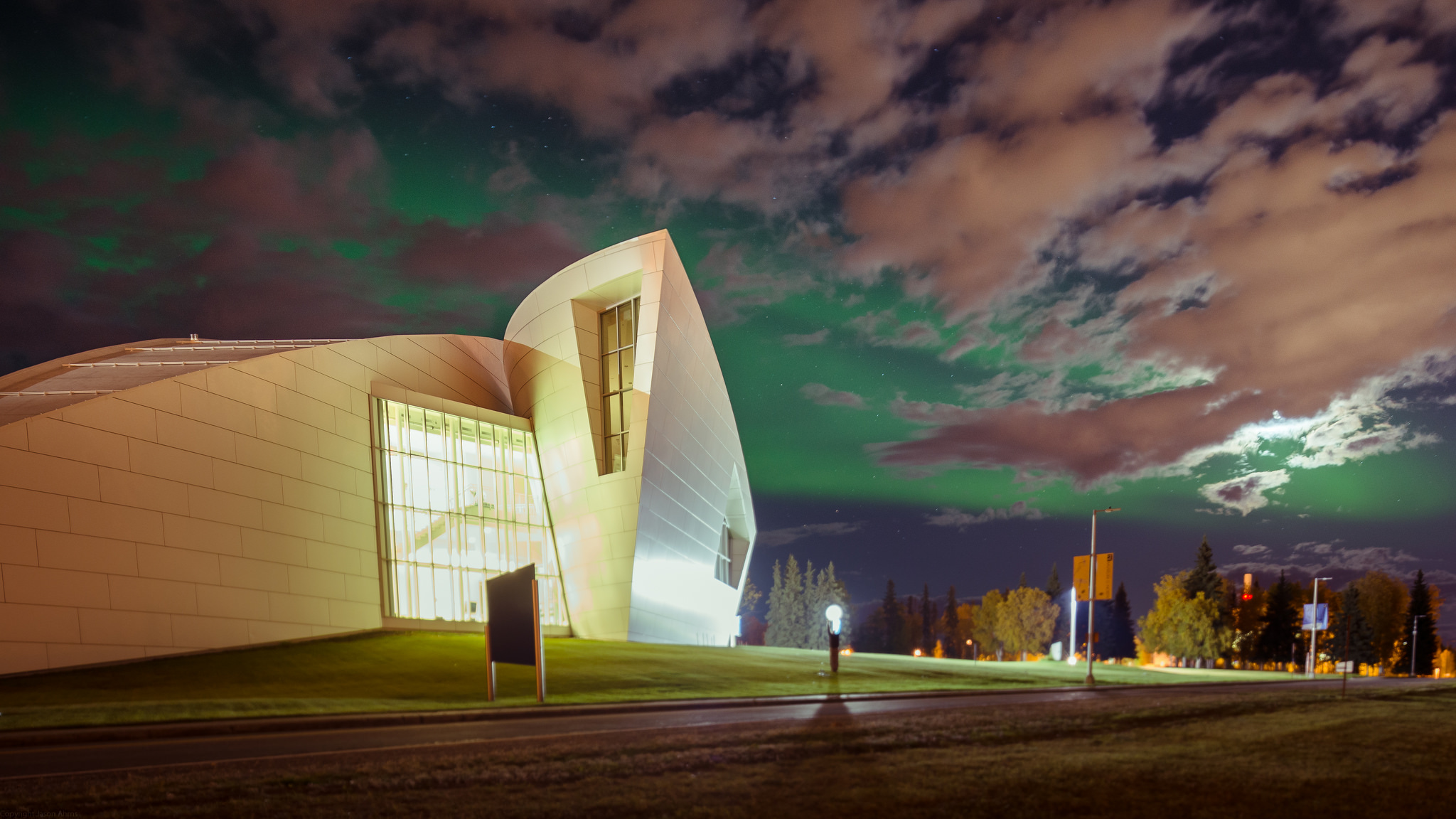
UA Museum of the Norh at night
Photo by Jason Ahrns

UA Museum of the North
Photo by Jason Ahrns

UA Museum of the Norh side view
Photo by Jason Ahrns

Visitors were offered a sneak peak at the normally unseen rooms and artifacts during a behind-the-scenes tour of the UA Museum of the North’s basement
UAF photo by JR Ancheta
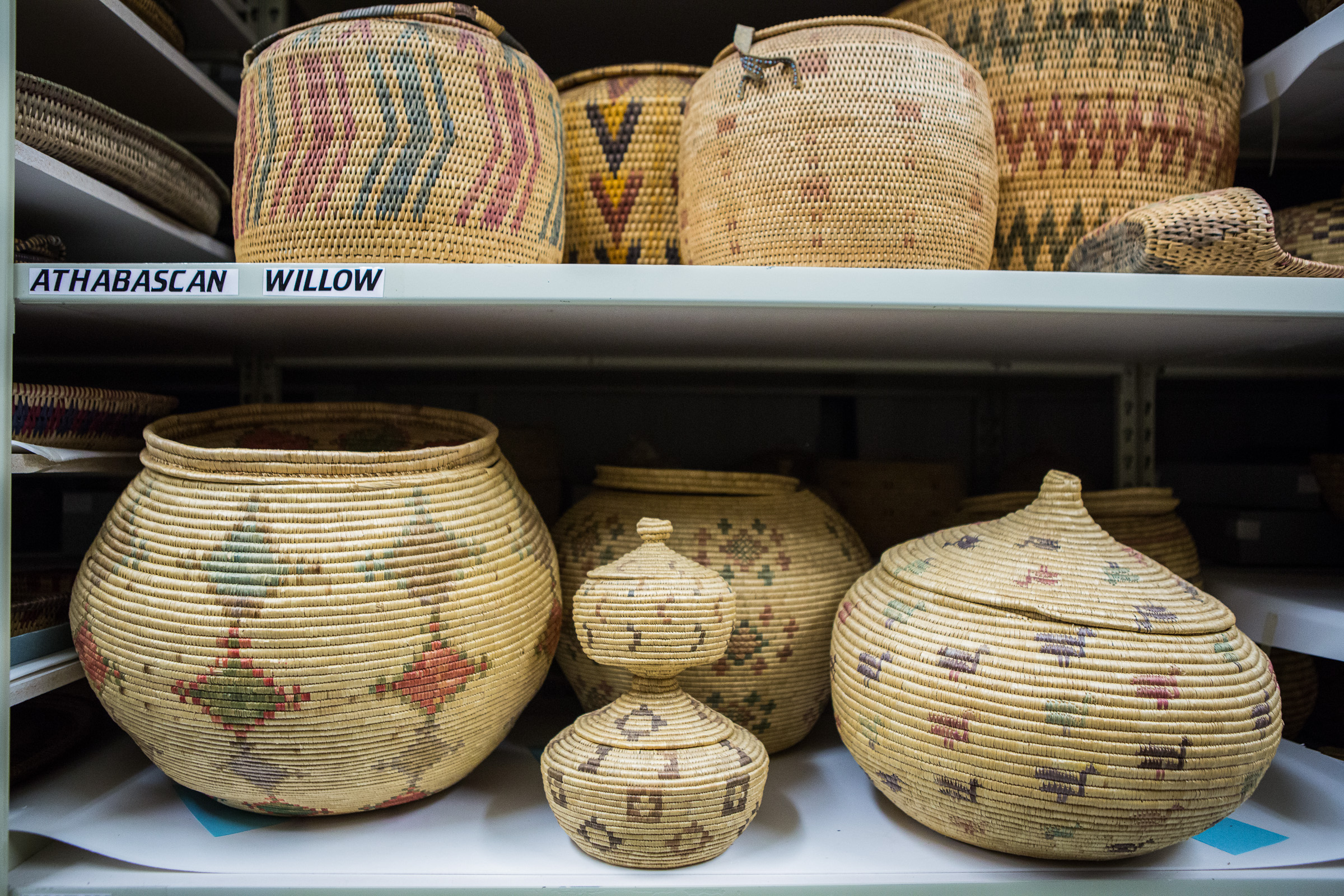
Visitors were offered a sneak peak at the normally unseen rooms and artifacts during a behind-the-scenes tour of the UA Museum of the North’s basement.
UAF photo by JR Ancheta

A mounted dinosaur skeleton display of Ugrunaaluk kuukpikensis, an Arctic duck-billed hadrosaur, stands near the entrance of the University of Alaska Museum of the North.
UAF photo by JR Ancheta
Alaska’s collegiate shooting team began in the 1930s, and the women’s team first landed on the national stage with a remarkable string of championships in the 1960s. In the 1990s, though, the team, by then a co-ed outfit, set its powder on fire. After winning the National Collegiate Athletic Association’s national championship in 1994, the team won nine more from 1999 to 2008. Alumni Matt Emmons and Jamie Gray went on to win Olympic gold medals.
Shooting has been a part of the University of Alaska’s history since its earliest days, although not at first as a competitive sport.
During the university’s first few decades, the surrounding land remained mostly wilderness. Hunting by students was so common that President Charles Bunnell complained of it to colleagues in correspondence in the late 1940s. It wasn’t the gunfire. “The real concern Bunnell expressed was that students were bringing the caribou they shot back to their dorm room for butchering,” according to Darroll Hargraves, a longtime Alaska school administrator who studied Bunnell’s letters.
The school’s first shooting team organized in 1937. Under the coaching of Everad Horton from 1960-1967, the women’s team won multiple national championships.
The magic returned in the early 1990s under the leadership of Randy Pitney, who shot for the Nanooks as a student from 1968-1972. Pitney, who coached the team to national championships in 1994, 1999 and 2000, is credited with laying the foundation for the program’s continued success and recruiting some of the shooters who made it happen.
Pitney recruited Dan Jordan, a team member from 1997-1999 who went on to coach from 2005-2016. Another Pitney recruit was Matt Emmons, who earned the 2004 Olympic gold medal in the 50-meter prone event the year after he graduated.
Remarkably, Emmons won that event with a rifle borrowed from Jordan’s wife, Amber Darland. He needed the firearm because someone had vandalized his own before the U.S. Olympic team left for the competition in Athens.
Jamie (Beyerle) Gray won the gold medal in three-position shooting during the 2012 London Olympics.
Alaskans heartily support the program. More than 1,000 attended the NCAA championships at UAF in 2007. However, Alaska’s strength on the range has little to do with moose hunting, writer Doug Williams reported in an ESPN Page 2 article in 2011. Recruiting is the key.
“Alaska's reach is long, thanks to a pipeline built by Pitney to attract Europeans (especially Scandinavians) and the best from the U.S.,” Williams wrote. “His successors have fared just as well by selling success, support and atmosphere.” ESPN’s magazine ranked Jordan as the No. 11 recruiter in college sports nationwide earlier that year.
"There's a whole lot of support for us. That probably comes from Alaska and being part of the outdoors lifestyle and shooting and stuff like that. ... It's part of Alaska's heritage. You go up here, there's hunters and trappers, and guns are just part of it."
"I'd like to know so I could shake their hand and say thanks."
UAF’s agricultural school released its Sunshine barley variety in spring 2009, hoping it would give farmers and gardeners a grain tough enough to take Alaska’s cold climate. Researchers at the Agricultural and Forestry Experiment Station had worked on the barley variety since 1993. The hull-less feature means the grain needs little processing. Its early maturation time fits with Alaska’s short growing season. And a little frost doesn’t bother it. The Alaska Flour Co. in Delta Junction planted the seed and began grinding the harvest at its new commercial mill in December 2011.
Since the first federal agricultural experiment station arrived in the village of Rampart in 1900, researchers have been trying to find a grain variety that will consistently not only survive but flourish in Interior Alaska’s harsh climate.
Along the way, hopes have sometimes advanced faster than reality. In the late 1970s, Alaska’s state government decided to buy grain-hauling rail cars, build a grain terminal in Valdez and sell thousands of acres near Delta Junction to create a barley export industry. While some farmers found success, the grand vision flopped. Part of the problem was the lack of a reliable barley variety.
At UAF’s Agriculture and Forestry Experiment Station, work began in 1993 on the Sunshine barley. The research phase started in tightly controlled greenhouses. Then scientists sowed fields in Fairbanks, Palmer and Delta Junction.
The variety did well. It matured early enough to fit within the growing season. Researchers harvested respectable yields of nearly 2,500 pounds per acre. Tests conducted by the Cooperative Extension Service showed it worked well in the kitchen.
Sunshine barley also is hull-less, which greatly reduces the processing needed. It actually does have a hull, but it’s so lightly attached to the grain that it falls off during the harvest.
Alaskans soon saw the results on the shelves of local stores. Alaska Flour Co. in Delta Junction ground its first batch in December 2011 and began using Sunshine barley to create a variety of products. In subsequent years, the farm has been planting about 150 acres of made-in-Alaska Sunshine.
“I doubt there will be 100,000 acres of it in Alaska, but I see a niche. There will be small acres, small plots. And the demand might increase once people see it's great."
“I’m not trying to compete with Gold Medal.”
The ridge on which the University of Alaska Fairbanks sits became known as College Hill after James Wickersham dedicated a cornerstone above its eastern bluff in 1915. But the ridge had a much older name, one used by people who lived in the area before those of European heritage arrived. They called it “Troth Yeddha’,” meaning “wild potato ridge.” University regents gave that name to a park next to the UA Museum of the North in 2008. The U.S. Board on Geographic Names officially restored the entire ridge’s name in 2013.
Excavations above College Hill’s easternmost bluff uncovered more than 9,000 artifacts from the 1930s through the 1990s. The artifacts demonstrated generations of occupancy that predate the university by thousands of years.
Chief Peter John of Minto, in a 1994 speech at UAF, shared the ridge’s name before it became known as College Hill.
“What is Troth Yeddha’?” John asked the audience at the Rural Student Services’ annual Native Summit. “This word [came] from long time before the white people ever come around here. … Our great-, great-grandfather pick wild potatoes on this hill here. … That’s the reason why they used to camp on that lake, Troth Yeddha’ Mene’. They paddle up that [creek], Troth Yetth No’, to get to this hill.”
He also said they planted a feather on the ridge “so the younger people today could go to school.”
The speech helped spark an effort to officially restore the hill’s earlier name.
Robert Charlie, also from Minto, first suggested the idea. He joined James Kari, a professor emeritus of Alaska Native languages, and Annette Freiburger, Rural Student Services director, in a restoration campaign.
In 2008, the UA Board of Regents created Troth Yeddha’ Park between the University of Alaska Museum of the North and the Reichardt Building.
The campaign continued. After the UA Board of Regents and the Alaska Historical Commission endorsed the idea, the U.S. Board on Geographic Names formally named the ridge Troth Yeddha’ in 2013.
The next year, the university launched a fundraising effort, the Troth Yeddha’ Legacy initiative, to develop the park and build an Indigenous studies center there.
“Our great-, great-grandfather plant that eagle feather on this hill here so that the younger people today could go to school and try to learn the true meaning what the Athabascan Indians were. That’s not written in history, but you young people is there to accomplish that goal today.”
“In making story, he hopes to script a world that, once made, can be stepped into and lived as a proactive experience. … He tells a story of finding a magic feather … which is used to ‘draw up a nation’ of opposed tribes, an act which saves the people from starvation. Implicitly, he invites the tribe of the ‘white man’ into a beneficial relationship with the ‘Indian.’ His use of words to ‘create’ reality reflects a different assessment of the nature (and power) of speech.”
YouTube video from Alaska Native Language
YouTube video from University of Alaska Fairbanks
YouTube video from University of Alaska Fairbanks
YouTube video from University of Alaska Fairbanks
UAF jumped to the forefront of national efforts to develop uses for drones in December 2013 when the Federal Aviation Administration chose it to lead one of only six federally authorized test ranges. The UAF-led range involves other organizations in an area roughly centered on the northern Pacific Ocean.
UAF began its organized effort to develop unmanned aircraft systems in 2001, but the effort expanded and grew more focused when the UA Board of Regents officially created the Alaska Center for Unmanned Aircraft Systems Integration in December 2012.
A year later, the Federal Aviation Administration selected the center to lead the Pan-Pacific UAS Test Range Complex. The complex involves state partners in Oregon and Hawaii, which, like Alaska, have designated test range areas. The complex also has a range in Iceland.
ACUASI already has put drones to work in numerous fields.
Public safety needs were an immediate source of interest. The center sent a drone over the 200,000-acre Funny River Fire on the Kenai Peninsula in 2014 to help crews identify hotspots within its perimeter. In 2016, the center helped search for a missing boy near Fairbanks by launching a drone with an infrared sensors that could “see” into forests. The drone didn’t find the boy — a motorist did — but the information helped narrow the search area, making efforts more efficient.
Drones are also helping to watch wildlife with ACUASI’s help. In 2015, the center subcontracted with Northern Embedded Solutions, a Fairbanks company founded by UAF engineering students, to help a UAF researcher track sea otters.
ACUASI has also participated in cutting-edge science work on a national and international scale. In September 2016, staff helped track a high-altitude glider from its release by a balloon 13 miles above the Earth to its landing in Oregon. The NASA-funded project was part of a study of next-generation space planes.
ACUASI’s complex in 2017 also helped test the ArcticShark, a drone with a 22-foot wingspan that will carry more than a dozen instruments to sample Arctic air starting in 2018.
But drones are also just plain fun. In December 2017, the center held drone races in the Patty Center ice arena on the Fairbanks campus. Staff had already built a test course in the basement of the Akasofu Building — a series of hoops suspended from the ceiling and surrounded with nets.
“We have a lot of times where we’ve got search-and-rescue where we’re looking with eyeballs and helicopters flying around, but you can’t see through foliage. … (With the drone-mounted infrared) we could actually see, through the foliage, what was actually going on on the ground. It was really a great capability that I think we’ll have a lot of applications for in the future.”
“It’s virtual reality in the sense that you’re inside the machine. It’s like you’re there moving. In fact, a lot of times if they’re not sitting down with their head down, they can get sick.”
In the course of just a few years, UAF began work on a new heat and power plant, a biology building on West Ridge, a dining facility in Wood Center and an engineering building next to Duckering. Work progressed at different rates, but all will be done by 2018, completing the most dramatic changes to the Fairbanks campus landscape in decades.
On Dec. 11, 1998, a boiler tube in UAF’s heat and power plant blew up just as the outside temperature dropped to minus 22 degrees. Temperatures in university buildings began to fall. About 10 hours later, employees were able to restart the plant, heading off a campuswide evacuation by just an hour.
The incident illustrated the risks posed by the aging plant, whose main boilers were installed in 1964.
University officials put a new plant on the top of their wish list, but securing money for such an enormous project took many years. Using state grants and money from a revenue bond, work on the $245 million project began in July 2015. The university plans to open the new, coal-fired heat and power plant in 2018, 20 years after the dramatic December boiler tube failure.
A 34,000-square-foot expansion of the William Ransom Wood Center created a new central dining facility for the Fairbanks campus when it opened in August 2014.
The new facility, which replaced the 51-year-old Lola Tilly Commons, also features a coffee shop and remodeled student services offices. A portrait of Lola Tilly, a beloved professor from the university’s early years, hangs in the new 420-seat dining hall.
The 2014 expansion was financed, designed and built by private companies. UAF will lease the building for 30 years and then will take ownership. The plan limited the amount of up-front construction money needed from the state.
The expansion represented a favorite milestone for then-Chancellor Brian Rogers. He was a student when the Legislature approved a $4 million loan to build the original Wood Center, completed in 1972. Eight years later, as a state legislator, Rogers obtained state money to pay off the debt.
The ribbon-cutting and dedication of the Margaret Murie Building was held Aug. 22, 2013. The building was named for the first woman graduate of the Alaska Agricultural College and School of Mines, which eventually became the University of Alaska Fairbanks.
Murie grew up in Fairbanks. She and her husband, Olaus, later became nationally known wilderness advocates.
The facility has nearly 100,000 square feet of state-of-the-art laboratories, classrooms and office space, as well as a 150-seat auditorium. The building serves as a central home for the Department of Biology and Wildlife and supports research and teaching in biology, physiology and infectious diseases.
The $88 million in construction money came from a statewide bond issue approved by Alaska voters in August 2010 after a long campaign advocating for a new life sciences building.
Engineering enrollment grew rapidly in the first decade of the 21st century, and UAF needed new space to adequately meet the demand. UA regents approved a new building in 2010, but funding lagged.
The Alaska Legislature supplied part of the money, so construction began in 2013. However, legislators declined to provide more funding in 2015, so the work halted in August that year. It didn’t resume until a year later, after regents approved alternative financing.
A ribbon-cutting was held in December 2017, and classes were to begin in January 2018.
The six-story Engineering Learning and Innovation Facility, nestled between the Duckering and Bunnell buildings, features open labs, a cold room, a 48-foot high bay for testing large structures and a “strong floor” that can support extremely heavy items.
“It’ll be a hub for campus life.”
“It was raining in our electrical distribution system. There was an inch of water on the floor.”
“We had to replace the power plant because it was 50 years old and it was failing. It could’ve been a major catastrophe if that plant had gone down in the middle of winter.”
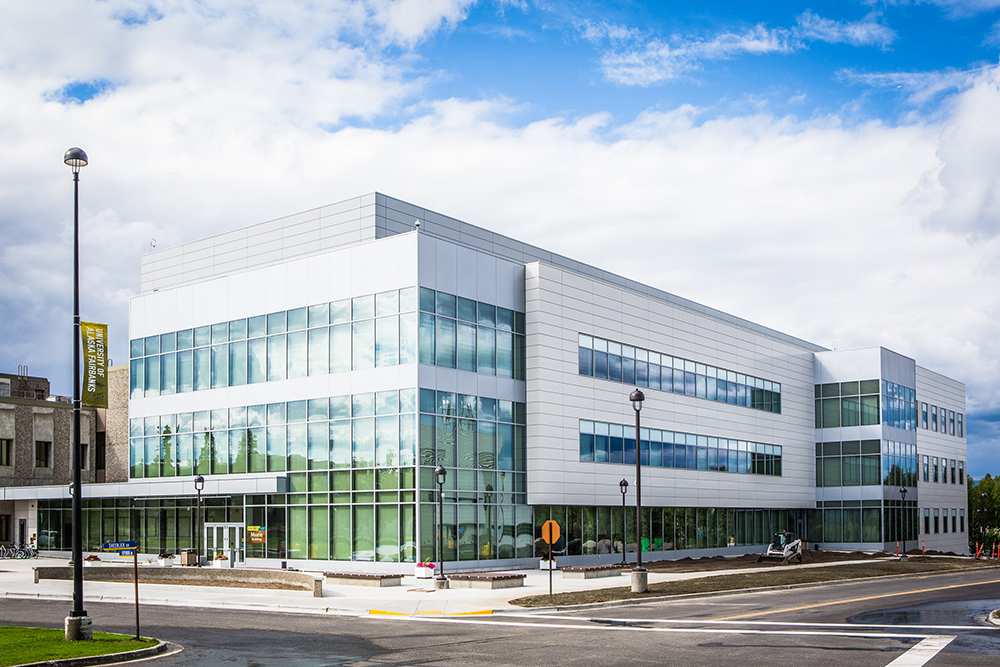
Margaret Murie Building
UAF photo by JR Ancheta

William Ransom Wood Center
UAF photo by Todd Paris

Engineering Learning and Innovation Facility
UAF photo by JR Ancheta

Heat and Power
UAF photo by JR Ancheta
The research vessel Sikuliaq, which UAF operates for the National Science Foundation, arrived in its homeport of Seward on Feb. 23, 2015. The 261-foot oceanographic vessel can break through ice 2.5 feet thick. That makes it able to handle more spring and fall conditions in the Arctic and Antarctic, extending the annual window during which ship-based scientists can study polar oceans. The Sikuliaq hosts up to 26 scientists and students on a voyage.
On a cold Wisconsin day in October 2012, the newest, most advanced oceanographic research ship in the United States slid down a set of rails and splashed into Lake Michigan.
A few moments before, Vera Alexander had christened the vessel “Sikuliaq,” an Inupiaq word meaning “young sea ice.”
Alexander, who worked on the ship’s design starting in the 1970s, served for decades as a faculty member and dean in what is today the UAF College of Fisheries and Ocean Science.
“It was a long, long odyssey,” she said of the effort to make the ship a reality. After scientists settled on the needed features, Congress approved $1 million for a detailed design in 2001.
Finally, in an economic stimulus bill passed after the 2008 U.S. financial meltdown, Congress provided $200 million for construction.
A few years of sea trials followed the christening in 2012. On Feb. 23, 2015, the Sikuliaq sailed into Seward, its homeport on the Gulf of Alaska coast.
Though operated by UAF, the ship is part of the University-National Oceanographic Laboratory System, and scientists from across the globe use it.
From the Sikuliaq (pronounced see-KOO-le-auk), researchers can collect seafloor sediments, guide remotely operated vehicles, winch scientific equipment throughout the water column and take samples with a wide variety of instruments. The ship’s design minimizes underwater noise to avoid disturbing marine mammals and fish.
“There’s a lot of dedicated cable trays, transits and science connectivity. In order to do what traditionally was a nightmare, to run cables when scientists came onboard, is an easy dream. We can plug and play and have science up in a couple of hours.”
“The research ships are probably my favorite, for two reasons — because the people who work here really want to be here, and I enjoy the interaction with the scientists. I like learning about what they are studying and that we have a real mission, a purpose for being out.”

A view inside the bridge on board the R/V Sikuliaq while it sits at the dock in Juneau during a stopover on its inaugural voyage to its home port of Seward in Feb., 2015.
UAF photo by Todd Paris.

A view of one of the labs off the main deck of the R/V Sikuliaq as it sits at the dock in Juneau during a stopover on its inaugural voyage to its home port of Seward in Feb., 2015.
UAF photo by Todd Paris.

Dan Oliver, left, marine superintendent, and Steve Hartz, science support lead on the R/V Sikuliaq, keep track of activity on various computer monitors from a lab off the main deck as the ship sits at the dock in Juneau during a stopover on its inaugural voyage to its home port of Seward in Feb., 2015.
UAF photo by Todd Paris.

A view of the engine room on board the R/V Sikuliaq as the ship sits at the dock in Juneau during a stopover on its inaugural voyage to its home port of Seward in Feb., 2015.
UAF photo by Todd Paris.

Jean Lavache, an engineer on board the R/V Sikuliaq, works on one of the primary winches on board the ship as it sits at the dock in Juneau during a stopover on its inaugural voyage to its home port of Seward in Feb., 2015.
UAF photo by Todd Paris.

Engineer Jean Lavache monitors activity throughout the ship from a control room on board the R/V Sikuliaq while the ship was docked in Juneau during a stopover on its inaugural voyage to its home port of Seward in Feb., 2015.
UAF photo by Todd Paris.

A view of the back deck on board the R/V Sikuliaq while the ship was docked in Juneau during a stopover on its inaugural voyage to its home port of Seward in Feb., 2015.
UAF photo by Todd Paris.

The R/V Sikuliaq sits tied up at a dock in its home port of Seward prior to its formal commissioning ceremony on March 7, 2015.
UAF photo by Todd Paris.
YouTube video by daveo21
UAF took over the High-frequency Active Auroral Research Program from the U.S. Air Force in 2015. The HAARP’s vast antenna array near Gakona helps study the the ionosphere, although conspiracy theorists claim it’s aimed at controlling everything from human minds to weather.
The solar wind drives the aurora borealis in the atmosphere far above Alaska, but UAF now has a tool that lets scientists create their own tiny replicas of that phenomenon.
In August 2015, the U.S. military turned over the High-frequency Active Auroral Research Program to UAF. Built at an initial cost of $290 million, the program’s most prominent feature is a huge antenna array near Gakona that’s powered by five diesel-fired generators.
By focusing the antenna’s signals in the ionosphere, researchers can create small radio-induced auroras, or airglows.
“Artificial airglow can teach us things about natural aurora,” said Chris Fallen, a research assistant professor at the UAF Geophysical Institute.
The ionosphere-stimulating signals can also affect radio communication. In 2013, scientists with the U.S. Naval Research Laboratory used the antenna to sustain a high-density plasma cloud for more than an hour, the longest period to date. “The plasma clouds, or balls of plasma, are being studied for use as artificial mirrors at altitudes 50 kilometers below the natural ionosphere and are to be used for reflection of [high-frequency] radar and communications signals,” the lab explained in a news release.
With UAF now operating HAARP, investigations of the upper atmosphere have continued.
In February and September 2017, Fallen used the HAARP antennas to create airglows, which are potentially visible to the naked eye. He shared updates about his experiment via Twitter.
“My Twitter account went from an account with about zero traffic — my mom, maybe — to a large increase during the campaign,” Fallen said. “It was cool to see how many people were really engaged and enthusiastic about it.”
“If you go out and look on the internet, you will find lots of interesting information about HAARP. It’s pretty interesting stuff; I enjoy it. I’ll just bring up this quote from Mark Twain: ‘You can’t depend on your eyes when your imagination is out of focus.’”
“It’s like putting a space heater in your backyard on a cold day. If you put your hand right in front of it, it feels hot. But when you turn the heater off, the warmth goes away quite quickly.”
YouTube video by KTVF Channel 11 Fairbanks
UAF kicked off the centennial celebration with an enhanced version of the traditional Sparktacular fireworks show on West Ridge. KUAC-FM broadcast “Variations on Happy Birthday” — performed by the Chamber Orchestra Kremlin and Misha Rashlevsky — in synchrony with the fireworks.
UAF then held multiple special events throughout the anniversary year.
They included a celebration and re-enactment of the signing of the university’s founding legislation, numerous lectures featuring prominent faculty and administrators, a midsummer Nanook Rendezvous for alumni, a talk by National Public Radio correspondent Shankar Vedantam, a “Centennial” overture performance, and even a keg-tapping to taste beer made from UAF-grown barley.
"Gosh, but we had a close call!"
“For an instant, my mind flashed back to the moment in 1922 when I had stood looking up at our one frame building perched on the hill and had wondered despondently if it could possibly have any future. In the sketches before me now, I could see what the future of the university was going to be, and it was a great one.”
“The placer mining camp of Fairbanks did not wither. Indeed, the industry created not only a strong economy but also a great partnership with the university and its students. As the decades passed, research and creative arts of all sorts flourished on campus, fulfilling [Judge James] Wickersham’s hope that the university would become, ‘a fountainhead for the general diffusion of knowledge among the people of Alaska.’”
“We’ve had ups and downs, but, with the support of Alaskans, they’ve mostly been ups. Alaskans have made sure that the university not only has remained open but also has thrived. With that backing, we’ve grown to become a world-class institution where a student can get a fine education in a wide range of fields.
We can’t stand still, though. We must continue to adapt and lead in new directions, always serving the needs and interests of Alaskans.
That’s because, although we are celebrating 100 years, a successful next century will depend on many voices across the state joining in the demand that our university remain strong for the generations to come.”